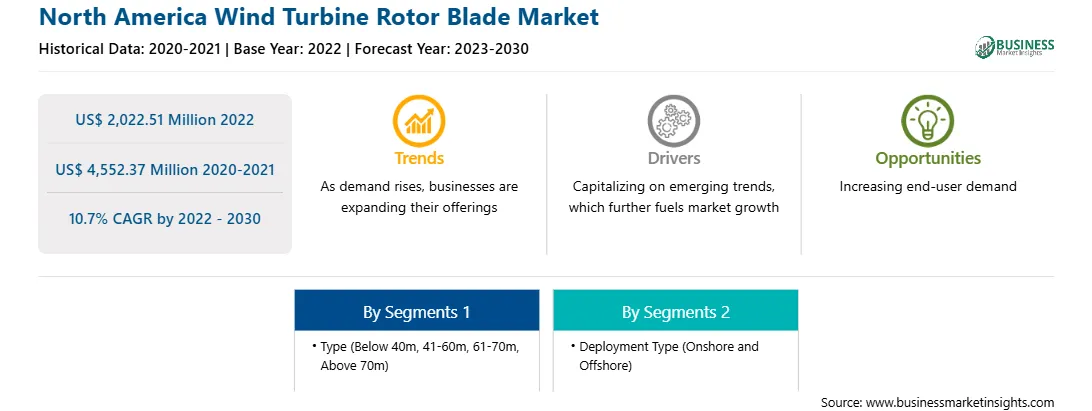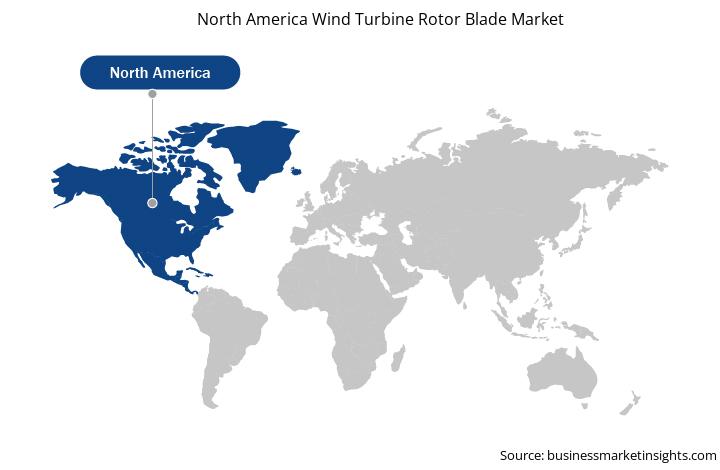The North America wind turbine rotor blade market was valued at US$ 2,022.51 million in 2022 and is expected to reach US$ 4,552.37 million by 2030; it is estimated to grow at a CAGR of 10.7% from 2022 to 2030.
The demand for energy has rapidly increased since 2000 owing to factors such as industrialization, urbanization, increasing population, and technological developments. As per the IEA’s report, investment in renewable energy has been significantly boosted by the rebound from the COVID-19 pandemic-related downturn and the response to the global energy crisis. When comparing projections for 2023 with the data from 2021, annual investment in clean energy has increased far more quickly than that of fossil fuels throughout this time (24% vs. 15%). Global energy demand is increasing every day, resulting in an energy crisis and contamination of the environment due to carbon emissions. Energy derived from fossil fuels is unsustainable due to limited, depleting supply and the environmental impact. As a result, the trends of sustainable and clean energy production increased in the last few years. Many developed countries, such as the US, Germany, and China, took initiatives to solve the energy crisis issues, resulting in the development of the wind turbine industry.
As per the data published by the U.S. Energy Information Administration in 2022, primary energy consumption in the US was approximately 98 quadrillion British thermal units (Btu) in 2021, which accounted for ~16% of the global primary energy consumption. The electricity consumption in the US peaked in 2022, amounting to 4.05 trillion kWh. The residential sector accounted for 38.9% of total electricity consumption in 2022, whereas commercial and industrial accounted for 35.1% and 25.8% of total consumption, respectively.
As per the government data, in 2022, renewable energy sources amounted to 0.9 trillion kWh, which roughly accounted for 21% of the total US electricity generation.
In addition, as per the IREA (International Renewable Energy Agency), wind energy has developed rapidly since 2000, owing to R&D and reduction in developmental costs. Such factors have affected the development and installation of wind power positively. For instance, global onshore wind capacity increased from 178 GW in 2010 to 699 GW in 2020, whereas offshore wind capacity increased from 3.1 GW in 2010 to 34.4 GW in 2020. Moreover, during 2013-2022, wind energy continued to consolidate its dominance, attracting 32% of global renewable energy investments. Investments in offshore wind have picked up, attracting 8% of the total. Thus, with increased demand for electricity owing to growing population, urbanization, industrialization, and increased preferences for clean energy, the demand for onshore and offshore wind energy projects increased, ultimately driving the wind turbine blades market.
North America constitutes major economies such as the US, Canada, and Mexico. The North American wind industry is expected to register remarkable growth owing to stringent government regulations, favorable policies, increasing investment in wind power projects, and reduced cost of wind energy. In North America, the growing consumer awareness toward sustainability goals and the role of renewable energy and wind energy are expected to increase wind power installations in the region. North America accounted for 12% of total wind power installations in 2022, with the US accounting for more than 85% of new capacity additions in the region.
Wind energy in the US grew at a record growth in the last five years, which represents the largest source of new additions to the US electric-generating capacity. Wind power provides 10% of electricity in 16 states and over 30% in Iowa, Kansas, Oklahoma, South Dakota, and North Dakota. The performance of wind energy technologies, coupled with the production tax credit and lower cost of power generation, accelerated the addition of wind energy capacity. Thus, a rise in investment toward building wind power projects in North America is expected to drive the growth of the wind turbine rotor blade market.
Strategic insights for the North America Wind Turbine Rotor Blade provides data-driven analysis of the industry landscape, including current trends, key players, and regional nuances. These insights offer actionable recommendations, enabling readers to differentiate themselves from competitors by identifying untapped segments or developing unique value propositions. Leveraging data analytics, these insights help industry players anticipate the market shifts, whether investors, manufacturers, or other stakeholders. A future-oriented perspective is essential, helping stakeholders anticipate market shifts and position themselves for long-term success in this dynamic region. Ultimately, effective strategic insights empower readers to make informed decisions that drive profitability and achieve their business objectives within the market. The geographic scope of the North America Wind Turbine Rotor Blade refers to the specific areas in which a business operates and competes. Understanding local distinctions, such as diverse consumer preferences (e.g., demand for specific plug types or battery backup durations), varying economic conditions, and regulatory environments, is crucial for tailoring strategies to specific markets. Businesses can expand their reach by identifying underserved areas or adapting their offerings to meet local demands. A clear market focus allows for more effective resource allocation, targeted marketing campaigns, and better positioning against local competitors, ultimately driving growth in those targeted areas.North America Wind Turbine Rotor Blade Strategic Insights

North America Wind Turbine Rotor Blade Report Scope
Report Attribute
Details
Market size in 2022
US$ 2,022.51 Million
Market Size by 2030
US$ 4,552.37 Million
Global CAGR (2022 - 2030)
10.7%
Historical Data
2020-2021
Forecast period
2023-2030
Segments Covered
By Type
By Deployment Type
Regions and Countries Covered
North America
Market leaders and key company profiles
North America Wind Turbine Rotor Blade Regional Insights

The North America wind turbine rotor blade market is segmented based on type, deployment type, and country. Based on type, the North America wind turbine rotor blade market is segmented into Below 40m, 41-60m, 61-70m, and Above 70m. The 61-70m segment held the largest market share in 2022.
In terms of deployment type, the North America wind turbine rotor blade market is bifurcated into onshore and offshore. The onshore services held a larger market share in 2022.
Based on country, the North America wind turbine rotor blade market is segmented into the US, Canada, and Mexico. The US dominated the North America wind turbine rotor blade market share in 2022.
TPI Composites Inc, Vestas Wind Systems AS, ENERCON GmbH, LM Wind Power AS, Siemens Gamesa Renewable Energy SA, Acciona SA, Suzlon Energy Ltd, Nordex SE, and Envision Energy USA Ltd are some of the leading companies operating in the North America wind turbine rotor blade market.
1. TPI Composites Inc
2. Vestas Wind Systems AS
3. ENERCON GmbH
4. LM Wind Power AS
5. Siemens Gamesa Renewable Energy SA
6. Acciona SA
7. Suzlon Energy Ltd
8. Nordex SE
9. Envision Energy USA Ltd
The North America Wind Turbine Rotor Blade Market is valued at US$ 2,022.51 Million in 2022, it is projected to reach US$ 4,552.37 Million by 2030.
As per our report North America Wind Turbine Rotor Blade Market, the market size is valued at US$ 2,022.51 Million in 2022, projecting it to reach US$ 4,552.37 Million by 2030. This translates to a CAGR of approximately 10.7% during the forecast period.
The North America Wind Turbine Rotor Blade Market report typically cover these key segments-
The historic period, base year, and forecast period can vary slightly depending on the specific market research report. However, for the North America Wind Turbine Rotor Blade Market report:
The North America Wind Turbine Rotor Blade Market is populated by several key players, each contributing to its growth and innovation. Some of the major players include:
The North America Wind Turbine Rotor Blade Market report is valuable for diverse stakeholders, including:
Essentially, anyone involved in or considering involvement in the North America Wind Turbine Rotor Blade Market value chain can benefit from the information contained in a comprehensive market report.